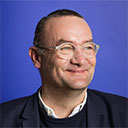Nr 91797229

Professor Karl Blossfeldt - Urformen der Kunst - 1929
Nr 91797229

Professor Karl Blossfeldt - Urformen der Kunst - 1929
VERY SCARCE GERMAN PHOTOBOOK CLASSIC.
FIRST AND MOST IMPORTANT BOOK by Prof Dr Karl Blossfeldt.
MENTIONED IN ALL RELEVANT BOOKS ABOUT PHOTOBOOKS:
- Andrew Roth, The Book of 101 Books, page 48
- Martin Parr, The Photobook, vol 1, page 96
- The Open Book, Hasselblad Center, page 66/67
- 802 photo books of the M.+M. Auer collection, page 133
Breath-taking photogravure printing.
Welcome to the LAST PHOTOBOOK AUCTION by 5Uhr30.com starting this year -
with more than 100 great lots from my personal collection and from recent acquisitions.
Like always we guarantee detailed and accurate descriptions, 100% transport protection, 100% transport insurance and of course combined shipping - worldwide.
Verlag Ernst Wasmuth A.G., Berlin. 1929. First edition, second printing
Hardback with full green cloth. 250 x 320 mm. 260 pages (20 pages with text, 240 pages with 120 black and white photographs). Photos: Professor Karl Blossfeldt. Introduction by Karl Nierendorf. Text in German.
Condition:
Inside all text and all photo pages fresh and flawless, clean with no marks and with no foxing; first two and last two pages foxed. Outside quiet fresh with only light trace of use; sign and golden letters on the front in brilliant fresh condition, overall better than usual. No jacket. Overall fine condition.
A CLASSIC, A MILESTONE in the history of photobooks.
WE THANK YOU SO MUCH to make our single-seller photobook auctions on Catawiki so successful.
Ecki Heuser & team are wishing ALL THE BEST TO YOU AND YOURS for 2025.
Karl Blossfeldt (1865-1932), German photographer known best for his stark close-up portraits of plants, twigs, seeds, leaves, and other flora.
In 1881 Blossfeldt began his studies as an apprentice at the Art Ironworks and Foundry in Mägdesprung, Germany, where he studied sculpture and iron casting. He then moved to Berlin to study at the School of the Museum of Decorative Arts (Kunstgewerbemuseum). In 1890 Blossfeldt received a scholarship to study in Rome under Moritz Meurer, a decorative artist and professor of ornament and design. Along with several other assistants, Blossfeldt created and photographed casts of botanical specimens in and around Rome. He continued to work with Meurer through 1896 and traveled beyond Italy to North Africa and Greece to collect specimens. Beginning in 1898 Blossfeldt taught design at the School of the Museum of Decorative Arts (Kunstgewerbeschule), and in 1930 he became professor emeritus. There he established a plant photography archive that he used to teach his students about design and patterns found in nature.
Blossfeldt had no formal training as a photographer and used homemade cameras that he outfitted with lenses capable of magnifying his subjects up to 30 times their natural size. The use of magnification resulted in images of extreme detail and clarity. With the precision of a botanist, Blossfeldt photographed the natural world for scientific and pedagogical purposes and inadvertently became a modern artist. His work was considered the forerunner to Neue Sachlichkeit photography, which favoured sharply focused documentarian images. In 1926, when Blossfeldt was already in his 60s, his work was exhibited to the public for the first time at Berlin’s avant-garde Galerie Nierendorf. The works exhibited there were published in the book Urformen der Kunst (1928; Art Forms in Nature [2003]). The first of his three photo books (the other two were Wundergarten der Natur, 1932; and Wunder in der Natur, 1942, the last published posthumously), it was enormously successful and remains one of the most-significant photo books of the 20th century.
Ten przedmiot został zaprezentowany w
Jak kupować w serwisie Catawiki
1. Odkryj coś wyjątkowego
2. Złóż najwyższą ofertę
3. Dokonaj bezpiecznej płatności
